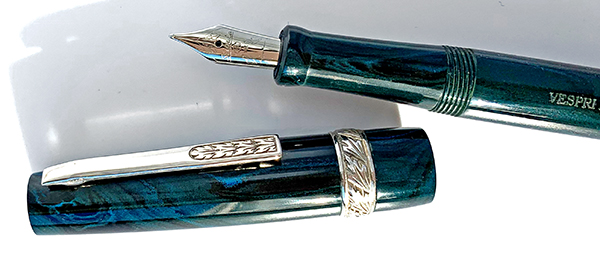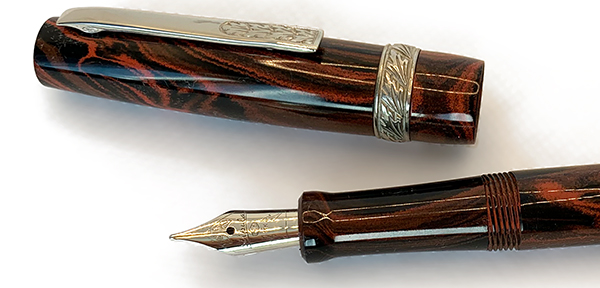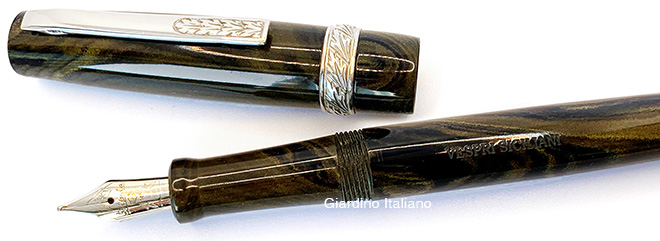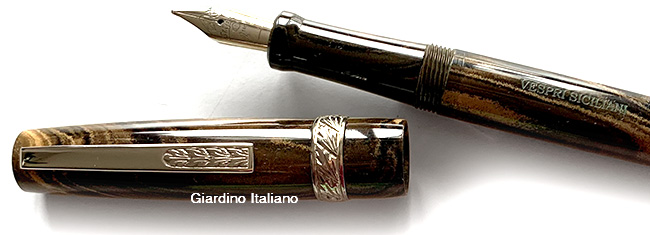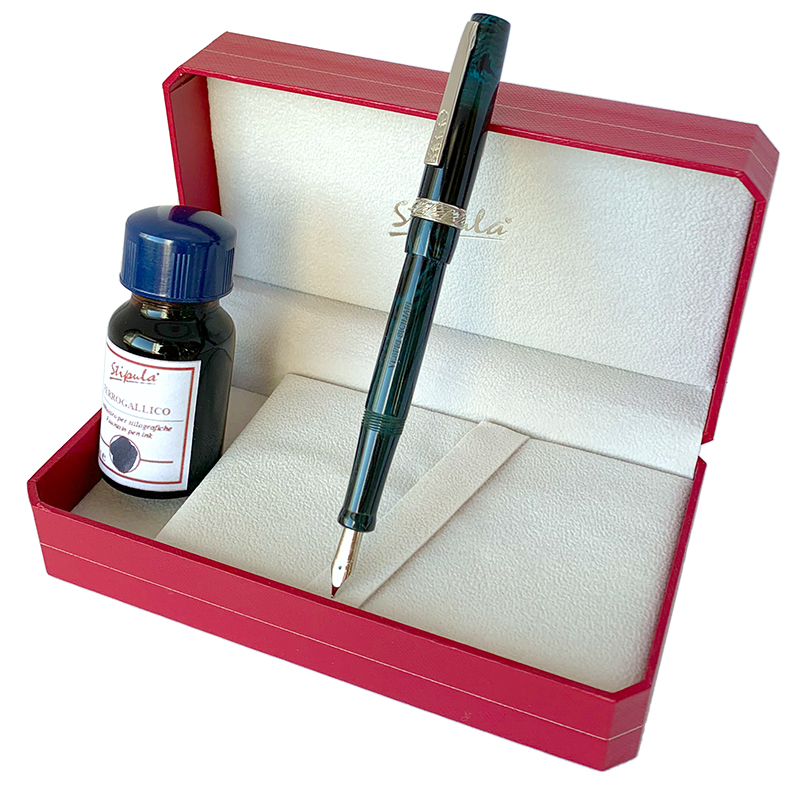 I want to talk again about pen maker Stipula, as I recently rediscovered a limited series of their ebonite pens called Vespri Siciliani (=Sicilian Vespers), which come with iron-gall ink.
I want to talk again about pen maker Stipula, as I recently rediscovered a limited series of their ebonite pens called Vespri Siciliani (=Sicilian Vespers), which come with iron-gall ink.
This unusual match pushed me to dig deeper into the story and features of this particular type of ink.
And, for real, is there anyone still thinking that inks are all the same?
A little history
Iron-gall ink has been the most used ink from the Middle Ages to the 1950’s. Good iron-gall ink has considerable quality, resistance, and colouring features. Even prior to the Middle Ages, the chemical reaction between tannin and iron salts was known. Pliny the Elder (23 – 29 B.C.) referenced it in his writings, and a few centuries later (in the Fifth Century) Latin prose writer Martianus Capella divulged a formula for the preparation of ink that he called “cocks and gums” (from Latin “gallarum gummeosque commixtio”).
His base formula was composed of four substances: galls from different trees (galls are tannin-rush extracts from various trees, such as oak, Aleppo tree, acorn, and some Oriental trees), vitriol (iron sulfate), resin (Arabic gum) obtained from the acacia tree and used as a binding agent between paper and ink, and water.
To modify the final features of the ink, the quantity of Gallic acid obtained by the first boil was increased or decreased by using different substances: beer or wine, vinegar or other acidic substances. Sugar, honey or resins were also used to modify the fermenting time and brightness of the ink. That type of ink would deeply penetrate into the paper, and was almost indelible. For this reason, iron-gall ink was used for centuries as “security ink”: it was difficult to completely eliminate it from the medium, even by abrasion.
Trivia from the original preparations is that iron-gall ink looks very clear when you first use it. As you apply it to the paper, the ink is so clear that it’s almost unreadable. It starts to darken only after a couple of seconds, triggered by the oxygen in the atmosphere. Because of this, the ink was prepared in advance to trigger a partial darkening and allow its reading as it was written on paper. However, it wasn’t possible to prepare the ink too much in advance because the oxidation process would cause precipitate particles that would reduce the ink quality.
Sometimes, to reduce these precipitates, pigments (red, blue, aniline, etc.) and some acidic substances (such as vinegar, sulfuric acid, etc.) would be added. To prevent the ink from freezing, brandy (or other alcohol preparations) would be added.
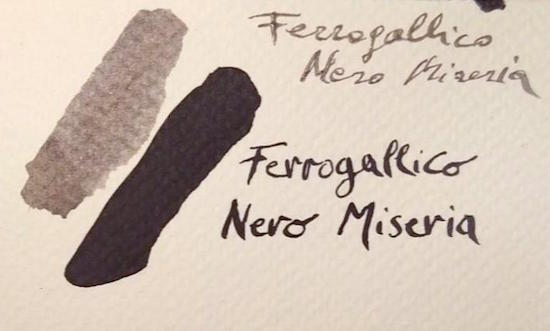
Once the ink dried, its colour would stay dark for many years. When all the excess iron in the ink composition oxidizes, the colour would turn to different shades of brown.
Iron-gall ink today
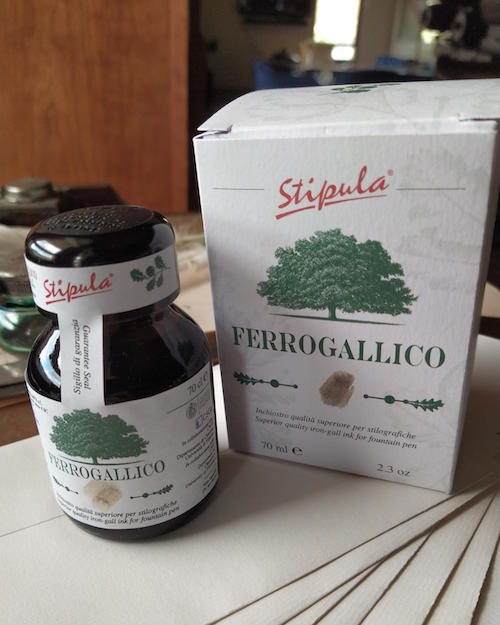 In cooperation with the Department of Chemistry at the University of Florence, Stipula has developed a new formulation of the iron-gall ink with total balancing of its chemical components.
In cooperation with the Department of Chemistry at the University of Florence, Stipula has developed a new formulation of the iron-gall ink with total balancing of its chemical components.
This new formula allows it to maintain all the typical characteristics of the Iron-gall (namely, its permanent mark on paper and persistent readability over time) and, at the same time, its full compatibility with its use in fountain pens and contact with metal nibs.
Stipula’s Iron-Gall ink is, in fact, produced under the supervision and expertise of the scientists at the University of Florence, with materials 99% pure and matching reagents.
Stipula’s iron-gall ink is, for this reason, a superior-quality modern ink.
Stipula’s Christmas offer
 In Stipula’s warehouses, some rare specimens of an unpublished series have come to light. These pens were designed over ten years ago. The Vespri Siciliani exist in very few specimens per type (two, three or maximum five), and they are all made of ebonite.
In Stipula’s warehouses, some rare specimens of an unpublished series have come to light. These pens were designed over ten years ago. The Vespri Siciliani exist in very few specimens per type (two, three or maximum five), and they are all made of ebonite.
Each pen is packaged in a gorgeous red box and comes with an iron-gall ink bottle by Stipula. These pens are now available for sale and that’s an offer to grab ASAP, as they are a very limited edition and at rebated price.
Ebonite is a hard material, yet frail. It’s acid resistant, but it softens when heated. It was invented in the mid 19th Century and is made of a mix of natural gums, sulfur, and other mineral and organic substances. This material was commonly used in the first fountain pens. Ebonite can be in a solid or grainy colour (often, this is a black grain). Nowadays ebonite is still used in musical instruments, for pipe embouchures, and valuable fountain pens.
The Vespri Siciliani are lean and regular-sized pens, made of ebonite of different colours. Each model is named after a region of Sicily, inspired to its fascinating and sunny nature, its wilderness, its volcanos, marine currents, and windy and rugged mountains.
Scilla and Cariddi
Scilla and Cariddi are two sea monsters guarding the Strait of Messina. The two pens that they inspired are made of green/black and blue/black ebonite:
.
Etna
Etna is made of pure black ebonite to recall the most famous active volcano of Sicily:
.
Stromboli
Stromboli is an active volcano in an island named after it in the Eolie archipelago. The pen recalls the flames and lapillus erupting from its mouth:
.
Valle del Bove
At the feet of Mount Etna, you can see the black desert rocks of Del Bove Valley lightened only by the fire of the volcano:
Ortigia
Ortigia is a small island connected to the mainland in front of the city of Siracusa:
.
Girgenti
This is the ancient name of the city of Agrigento. The pen takes the colours from the local rocks – yellow, gold, and black.
.
Capo Passero
Cape Passero is the southernmost point of the island, where two seas meet each other and merge their currents:
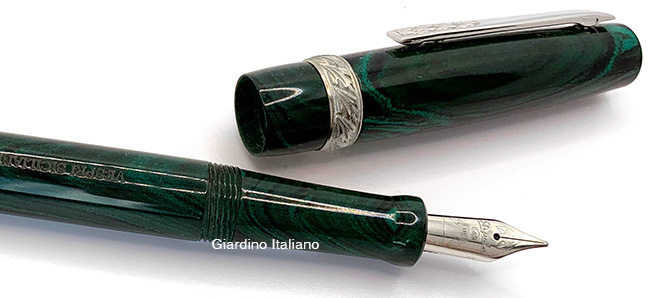
.
Modica
Modica is a town famous for its chocolate production in its varied flavours and for its baroque architecture:
The pen finishings (clip, ringlets, band, etc.) are of solid silver. The nib is a 5mm 14-karat gold, and comes in a range of widths: UltraFine, ExtraFine, Fine, Medium, and Bold, and two stubs (0.9 and 1.1).
How to clean your pen
Before inking a fountain pen – especially when you’re using an iron-gall ink – it needs to be thoroughly cleaned. In fact, different inks can interact with each other and form sedimentation that’s hard to remove. Here are some cleaning methods you can use:
- Take the fountain pen apart and wash it under running water; even better, put it in a ultra-sound cleaner with a little soap. Rinse well, and let it dry completely before you put it together again.
or
- Rinse the fountain pen with water and detergent, in the following order: fill the pen with water and soap, then let it dry with the nib touching an absorbent material. The liquid will slowly drain throughout the pen. Finally, rinse the pen with clean water a couple of times.
Other methods involving simply rinsing the pen won’t be as effective. Indeed, even if the pen seems clean after rinsing, the inlets of the pen will still contain ink residues. You can verify if your pen is properly cleaned by filling it with clean water and letting it stand for a day. When you remove the water, if it’s completely clear the pen is clean.
Changing ink in the pen without cleaning it first is not recommended.
Different inks have different properties, and the ink mixes could be incompatible. This forms precipitates that are difficult to remove.
How to rinse the pen
To rinse the pen you can use water and dish soap (use 2-3 ml of soap dissolved in 10-15 ml of water). This solution has a low superficial tension and can easily penetrate in all the tiniest corners and holes of the fountain pen. Rinse the pen with this solution multiple times, leave it to rest for a few minutes, and then rinse until there are no more soap traces.
If rinsing with a soap solution doesn’t give you satisfying results, add some ascorbic acid to the water – you can get that by crushing some Vitamin C compresses. Rinse the pen with this solution multiple times. The ascorbic acid will remove any ink residues (even iron-gall ink) from the pen.
Therefore…
Switching to iron-gall ink is not just a question of aesthetics, sophistication, or leisure: with its properties of oxidation and permanence, it’s a safe choice for daily use, today as it was in the past.
In combination with Stipula’s Vespri Siciliani pens, it’s an amazing Christmas gift!
.
Susanna Buffo
Giardino Italiano
.
.

